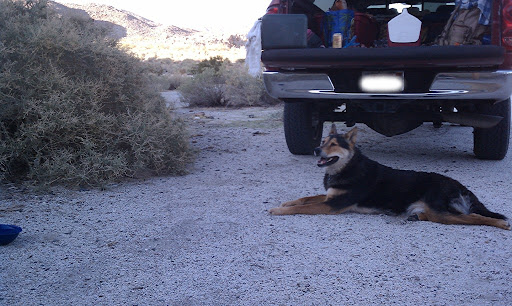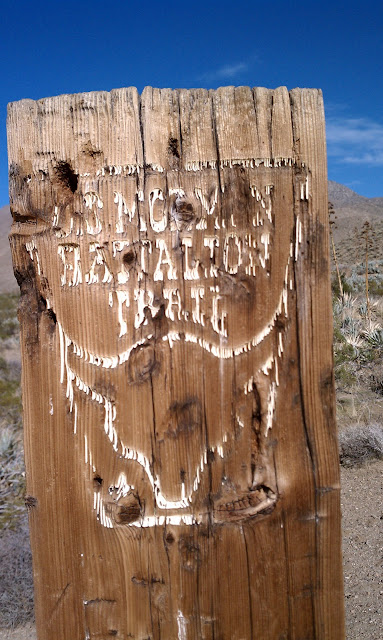|
dsefcik Administrator Posts: 2622
11/8/2010
|
This last weekend I went camping with my oldest son and our dog Rocky "Bones". I don't usually bring our dog because he is just too wild and unmanageable, I don't think there is much "domestic" in him, his focus most of the time is on chasing anything that moves, including coyotes. We did bring him though and managed his extreme desires to chase the jack rabbits, quail and lizards running thru the Bow Willow campground. This was really just a get away for the weekend, we drove out late Saturday and arrived at Bow Willow around 4pm. We only saw 3 other campers there so we picked a spot and made camp which was really only dragging the firewood out of the truck and getting Bones his water dish. The rest of the night was spent just stoking the campfire and enjoying the peacefulness of the desert.
Rocky Bones checking out some quail up on the hill:

I want to say that for anybody who thinks it is too much work to pack up camping supplies and drive for 2-3 hours just to camp out overnight...it is worth it, get out..go..it can't be beat. We heard coyotes howling at night and early morning dawn, saw many jack rabbits and quail and enjoyed a very peaceful night in the desert.
What has any of this got to do with the U.S. Mormon Battalion Trail? (do you even know what that is?) Well, our Sunday consisted of driving most of the ABDSP to do a driving tour and at one stop to let Bones out to walk I saw this sign post:

I had never heard of this before and did some research when I got home. This has quite a bit of history, quoting the Bill Sullivan, The Sand Paper, newsletter of the Anza-Borrego Desert Natural History Association, a CCHS member.:
"There was something different about the
battalion of soldiers that marched northward
from Vallecito on the 19th of January, 1847.
Indians had long gone this way. The Mexican
Army officer Santiago Arguello had chased
horse thieves in this direction. The American
General Kearny had passed through here, too.
What was different about these soldiers, the
U.S. Army’s Mormon Battalion, was that their
entourage included five wagons, and numerous
cattle and sheep. The western edge of the desert
wasn’t quite ready for wagons.
The soldiers, tired, hungry, thirsty, many
of them shoeless, had marched for six months
from Council Bluffs, Iowa. After crossing the
Sonoran Desert, they moved from the greenery
of Vallecito (this was five years before the stage
station) and came to the base of the Campbell
Grade. They needed an hour and a half to get
themselves, their livestock (horses, cattle, sheep
and mules) and their five wagons up the grade’s
steep 200 feet and into the Mason Valley. They
then moved on into Box Canyon where they
faced the nuisance of boulders on the ground
and the thorns of mesquite and catclaw, and two
major obstacles.
First, the canyon walls had to be chipped away (with hand tools, mostly
axes) to widen the passageway so the wagons could be pulled through.
Then, to avoid a narrow dry waterfall, a 30-foot wall in the middle of the
wash, they had to build a bypass road up and over a rocky hill full of cactus.
Less than an hour of daylight remained when the beleaguered battalion got
through to Blair Valley. When the commander, Lt. Col. Philip St. George
Cooke, was told that another obstacle, Foot and Walker Pass, stood in their
path, he gave the order to camp in Blair Valley, with the next water seven
miles away at the Indian village at San Felipe Creek.
It was a tough two days, after a strenuous six months, but because of
the soldiers’ work, emigrants to California had a southern route during the
Gold Rush, the Butterfield Overland Mail had a mail route in the 1850s and
’60s, and a few Californians had a route eastward to fight in the Civil War.
When engineers looked for trans-desert routes, they looked here and opted
to go up the east side of the Salton Sea instead. Anza-Borrego’s west-side
rocks were just too tough for them. The route through Anza-Borrego was
left to return to silence, and to us.
Today it’s possible to walk the 20-odd miles from the Vallecito stage
station by way of Foot and Walker Pass to Scissors Crossing, a mile and a
half south of the San Felipe station, but private property forces you to walk
part of the way along the highway. Most of us are likely to approach the
area with short day hikes.
At the north end of the Vallecito Valley, east of Highway
S-2, just before the Campbell Grade, is a small piece of the
state park. A marker stands beside the Mormon Trail. A path-
way, wide enough to accommodate a stagecoach, leads to the
foot of Campbell Grade where the trail becomes faint. Walk
the pathway and imagine how shoeless soldiers got through
the cactus with their bawling sheep and cattle."
There are more websites online that have the complete history of the Mormon battalion group, some are here:
http://mormonbattalion.com/Armyofthewest
http://www.desertusa.com/mag00/oct/papr/mormbat.html
www.californiahistorian.com/magazine2.../25%2027%20SanFelipe.pdf
http://en.wikipedia.org/wiki/Mormon_Battalion
--
http://www.sefcik.com
http://www.darensefcik.com
http://www.carrizogorge.com
|